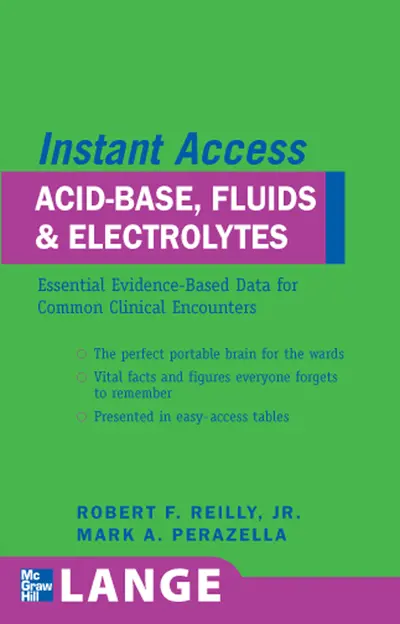My Account Details

ISBN10: 0071486348 | ISBN13: 9780071486347

Chapter 1: Body Fluid Compartments and Intravenous Fluid Replacement, Robert F. Reilly, Jr., and Mark A. Perazella
1. Body fluid compartments
2. Intravenous solutions
3. General principles
4. Assessing extracellular fluid volume
5. Fluid resuscitation
6. Clinical examples of fluid resuscitation
Chapter 2: Disorders of Sodium Balance (Edema, Hypertension or Hypotension), Robert F. Reilly, Jr., and Mark A. Perazella
1. Introduction
2. Regulation of Na+ transport in kidney
3. Disorders associated with increased total body Na+ (ECF volume expansion)
4. Clinical manifestations of increased total body Na+ (ECF volume expansion)
5. General approach to the edematous patient
6. General treatment of the edematous patient
7. Clinical manifestations of decreased total body Na+ (ECF volume depletion)
8. General approach to the volume depleted patient
9. General Treatment of the Volume Depleted Patient
Chapter 3: Disorders of Water Balance (Hypo- and Hypernatremia), Robert F. Reilly, Jr., and Mark A. Perazella
1. Introduction
2. Hyponatremia
3. Etiology of hyponatremia
4. Signs and symptoms
5. Diagnosis
6. Treatment
7. Hypernatremia
8. Etiology
9. Signs and symptoms
10. Diagnosis
11. Treatment
Chapter 4: Diuretics, Mark A. Perazella
1. Introduction
2. Sites of diuretic action in kidney
3. Diuretic resistance
4. Clinical conditions associated with diuretic resistance
5. Treatment of diuretic resistance
Chapter 5: Disorders of K+ balance (Hypo- and Hyperkalemia), Mark A. Perazella
1. Introduction
2. K+ homeostasis
3. Role of K+ in the resting membrane potential
4. Cellular K+ distribution
5. K+ handling by the kidney
6. Factors controlling renal K+ excretion
7. Hypokalemia8. Etiology
9. Increased cellular K+ uptake
10. Increased renal K+ losses
11. Approach to the patient
12. Clinical manifestations
13. Treatment
14. Hyperkalemia
15. Etiology
16. Approach to the patient
17. Clinical manifestations
18. Treatment
Chapter 6: Metabolic Acidosis, Dinkar Kaw and Joseph I. Shapiro
1. Acid-Base Chemistry and Biology
2. The Bicarbonate Buffering System
3. Acid Excretion by the Kidney
4. Clinical Approach to the Patient with an Acid-Base Disorder
5. Pathophysiology, Compensation and Consequences
6. Use of the Serum and Urine Anion Gap in the Differential Diagnosis of Metabolic Acidosis
7. Differential Diagnosis of Metabolic Acidosis
8. Causes of Metabolic Acidosis
9. Treatment of Metabolic Acidosis
Chapter 7: Metabolic Alkalosis, Dinkar Kaw and Joseph I. Shapiro
1. Introduction
2. Maintenance of Metabolic Alkalosis
3. Clinical Features
4. Differential Diagnosis
5. Cl--Responsive and Cl--Resistant Causes of Metabolic Alkalosis
6. Treatment
Chapter 8: Respiratory and Mixed Acid-base Disturbances, Youngsook Yoon and Joseph I. Shapiro
1. Respiratory Disturbances
2. Respiratory Acidosis
3. Respiratory Alkalosis
4. Mixed Disturbances
Chapter 9: Disorders of Serum Calcium, Robert F. Reilly, Jr.
1. Regulation
2. Hypercalcemia
3. Hypocalcemia
Chapter 10: Disorders of Serum Phosphorus, Robert F. Reilly, Jr.
1. Regulation
2. Hyperphosphatemia
3. Hypophosphatemia
Chapter 11: Disorders of Serum Magnesium, Robert F
Need support? We're here to help - Get real-world support and resources every step of the way.